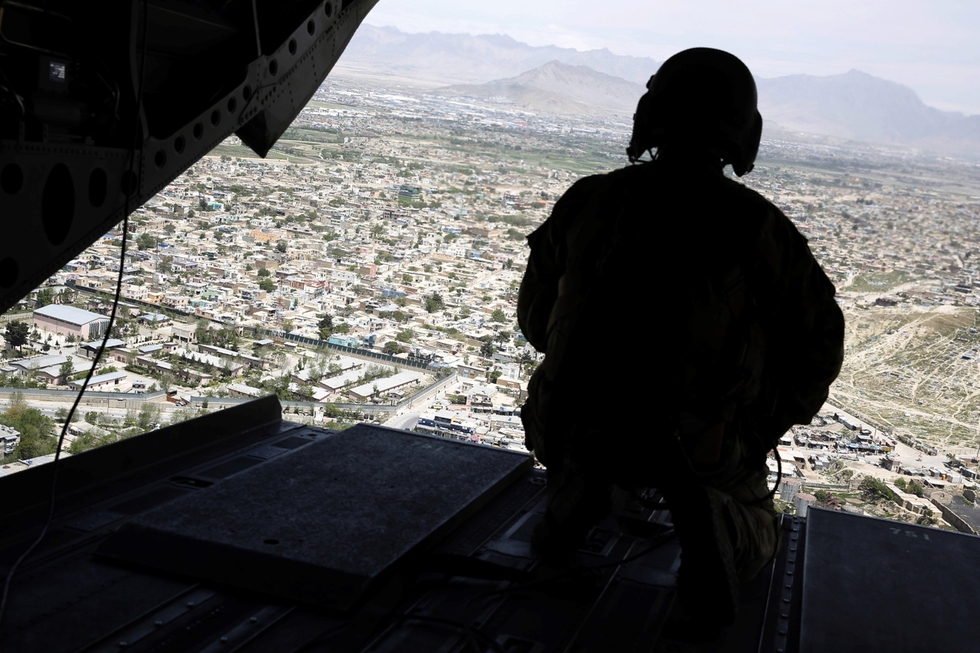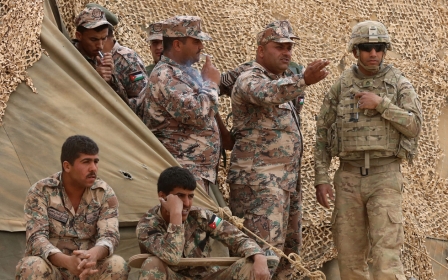Will Trump agree to the Pentagon's permanent war in Iraq, Afghanistan and Syria?

The two top national security officials in the Trump administration – Secretary of Defence James Mattis and national security adviser HR McMaster - are trying to secure long-term US ground and air combat roles in the three long-running wars in the greater Middle East – Afghanistan, Iraq and Syria.
Proposals for each of the three countries are still being developed, and there is no consensus, even between Mattis and McMaster, on the details of the plans. They will be submitted to Trump separately, with the plan for Afghanistan coming sometime before a NATO summit in Brussels on 25 May.
But if this power play succeeds in one or more of the three, it could guarantee the extension of permanent US ground combat in the greater Middle East for many years to come - and would represent a culmination of the “generational war” first announced by the George W Bush administration.
'Open-ended commitment'
It remains to be seen whether President Donald Trump will approve the proposals that Mattis and McMaster have pushed in recent weeks.
Judging from his position during the campaign and his recent remarks, Trump may well baulk at the plans now being pushed by his advisers.
The plans for the three countries now being developed within the Trump administration encompass long-term stationing of troops, access to bases and the authority to wage war in these three countries.
These are the primordial interest of the Pentagon and the US military leadership, and they have pursued those interests more successfully in the Middle East than anywhere else on the globe.
US military officials aren’t talking about “permanent” stationing of troops and bases in these countries, referring instead to the “open-ended commitment” of troops. But they clearly want precisely that in all three.
Shifting timetables
The George W Bush administration and the Barack Obama administration both denied officially that they sought “permanent bases” in Iraq and Afghanistan, respectively. But the subtext in both cases told a different story.
A Defense Department official testifying before Congress at the time admitted that the term had no real meaning, because the Pentagon had never defined it officially.
In fact, at the beginning of the negotiations with Iraq on the US military presence in 2008, the US sought access to bases in Iraq without any time limit. But the al-Maliki government rebuffed that demand and the US was forced to agree to withdraw all combat forces in a strict timetable.
Reversing withdrawals
Now the regional context has shifted dramatically in favour of the US military’s ambitions. On one hand, the war against Islamic State (IS) is coming to a climax in both Iraq and Syria, and the Iraq government recognises the need for more US troops to ensure that it can’t rise again; and in Syria, the division of the country into zones of control that depend on foreign powers is an overriding fact.
Meanwhile in Afghanistan, growing Taliban power and control across the country is being cited as the rationale for a proposal to reverse the withdrawals of US and NATO troops in recent years and to allow a limited return by US forces to combat.
Now that Islamic State forces are being pushed out of Mosul, both the Trump administration and the Iraqi government are beginning to focus on how to ensure that the terrorists do not return.
They are now negotiating on an agreement that would station US forces in Iraq indefinitely. And the troops would not be there merely to defeat IS, but to carry out what the war bureaucracies call “stabilisation operations” - getting involved in building local political and military institutions.
Plans for Syria
The question of what to do about Syria is apparently the subject of in-fighting between Mattis and the Pentagon, on one hand, and McMaster, on the other.
The initial plan for the defeat of IS in Syria, submitted to Trump in February, called for an increase in the size of US ground forces beyond the present level of 1,000.
As part of one plan, US ground troops would lead Sunni Arab troops to destroy IS in Syria rather than relying on Kurdish forces to do the job
But a group of officers who have worked closely with Gen Petraeus on Iraq and Afghanistan, which includes McMaster, has been pushing a much more ambitious plan, in which thousands – and perhaps many thousands - of US ground troops would lead a coalition of Sunni Arab troops to destroy Islamic State’s forces in Syria rather than relying on Kurdish forces to do the job.
Both the original plan and the one advanced by McMaster for Syria would also involve US troops in “stabilisation operations” for many years across a wide expanse of eastern Syria that would require large numbers of troops for many years.
Both in its reliance on Sunni Arab allies and in its envisioning a large US military zone of control in Syria, the plan bears striking resemblance to the one developed for Hillary Clinton by the Center for New American Security when she was viewed as the president-in-waiting.
Reversing Obama's Afghanistan policy
The Pentagon proposal on Afghanistan, which had not been formally submitted by Mattis as of this week, calls for increasing the present level of 8,400 US troops in Afghanistan by 1,500 to 5,000, both to train Afghan forces and to fight the Taliban. It also calls for resuming full-scale US air strikes against the Taliban. Both policy shifts would reverse decisions made by the Obama administration.
The US and NATO were not able to pressure the Taliban to negotiate with the government even when they had more than 100,000 troops in the country
Five past US commanders in Afghanistan, including Petraeus, have publicly caIled for the US to commit itself to an “enduring partnership” with the Afghan government. That means, according to their joint statement, ending the practice of periodic reassessments as the basis for determining whether the US should continue to be involved militarily in the war, an idea that is likely part of the package now being formulated by Mattis.
But the problem with such a plan is that the US military and its Afghan client government have now been trying to suppress the Taliban for 16 years. The longer they have tried, the stronger the Taliban have become. The US and NATO were not able to pressure the Taliban to negotiate with the government even when they had more than 100,000 troops in the country.
Committing the US to endless war in Afghanistan would only reinforce the corruption, abuses of power and culture of impunity that Gen Stanley A McChystal acknowledged in 2009 were the primary obstacles to reducing support for the Taliban. Only the knowledge that the US will let the Afghans themselves determine the country’s future could shock the political elite sufficiently to change its ways.
Most political and national security elites as well as the corporate news media support the push to formalise a permanent US presence in Afghanistan, despite the fact that national polls indicate that it is the most unpopular war in US history with 80 percent of those surveyed in a CNN poll in 2013 opposing its continuation.
Beltway brawl?
There are signs that Trump may reject at least the plans for Afghanistan and Syria. Only days after his approval of the missile strike on a Russian-Syrian airbase, Trump told Fox Business in an interview, “We’re not going into Syria.”
And White House spokesman Sean Spicer seemed to suggest this week that Trump was not enamoured with the plan to spend many more years trying to “transform” Afghanistan. “There is a difference between Afghanistan proper and our effort to defeat ISIS,” Spicer said
Despite Trump’s love for the military brass, the process of deciding on the series of new initiatives aimed at committing the US more deeply to three wars in the greater Middle East is bound to pose conflicts between the political interests of the White House and the institutional interests of the Pentagon and military leaders.
- Gareth Porter is an independent investigative journalist and winner of the 2012 Gellhorn Prize for journalism. He is the author of the newly published Manufactured Crisis: The Untold Story of the Iran Nuclear Scare.
The views expressed in this article belong to the author and do not necessarily reflect the editorial policy of Middle East Eye.
Photo: A US soldier mans a weapon at the tailgate aboard the helicopter carrying US Defence Secretary James Mattis as he arrives at Resolute Support headquarters in the Afghan capital Kabul on April 24, 2017. (AFP)
This article is available in French on Middle East Eye French edition.
New MEE newsletter: Jerusalem Dispatch
Sign up to get the latest insights and analysis on Israel-Palestine, alongside Turkey Unpacked and other MEE newsletters
Middle East Eye delivers independent and unrivalled coverage and analysis of the Middle East, North Africa and beyond. To learn more about republishing this content and the associated fees, please fill out this form. More about MEE can be found here.






